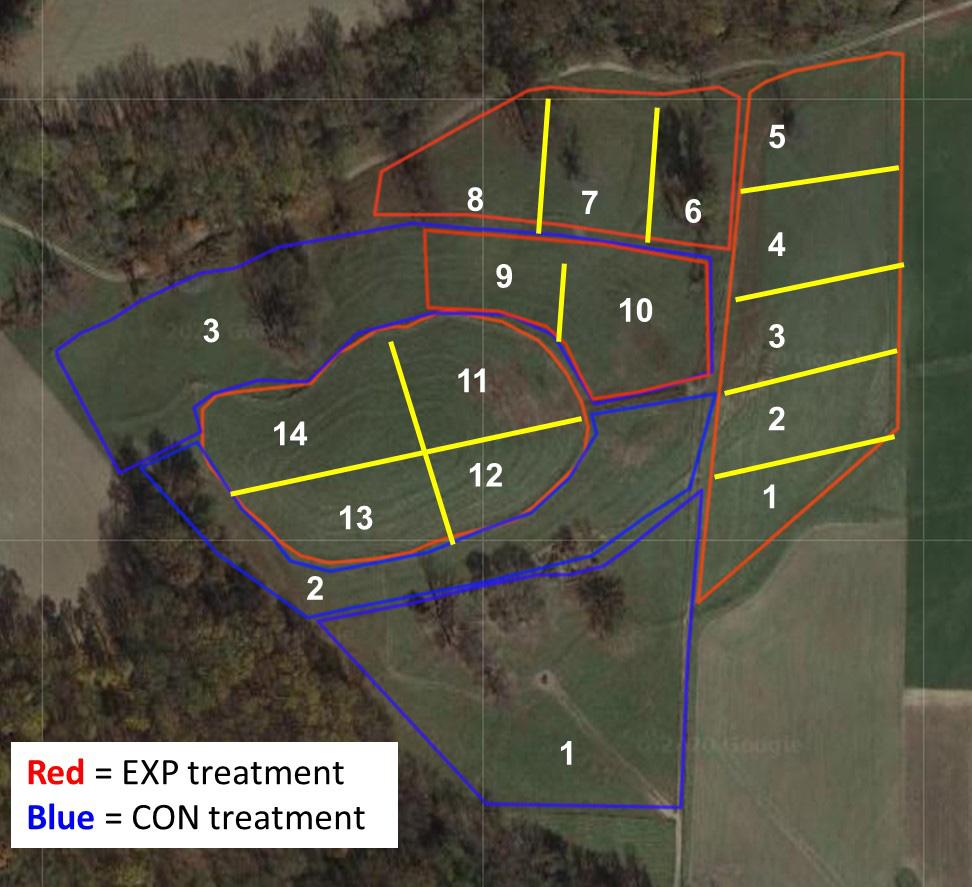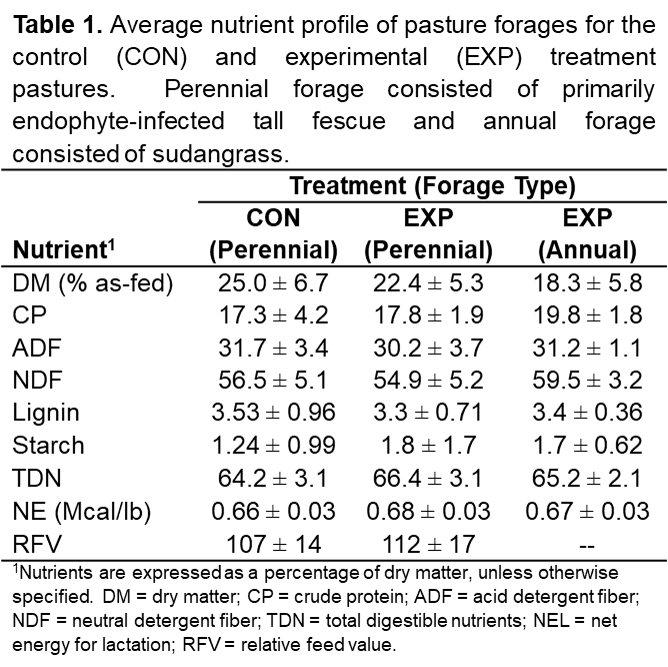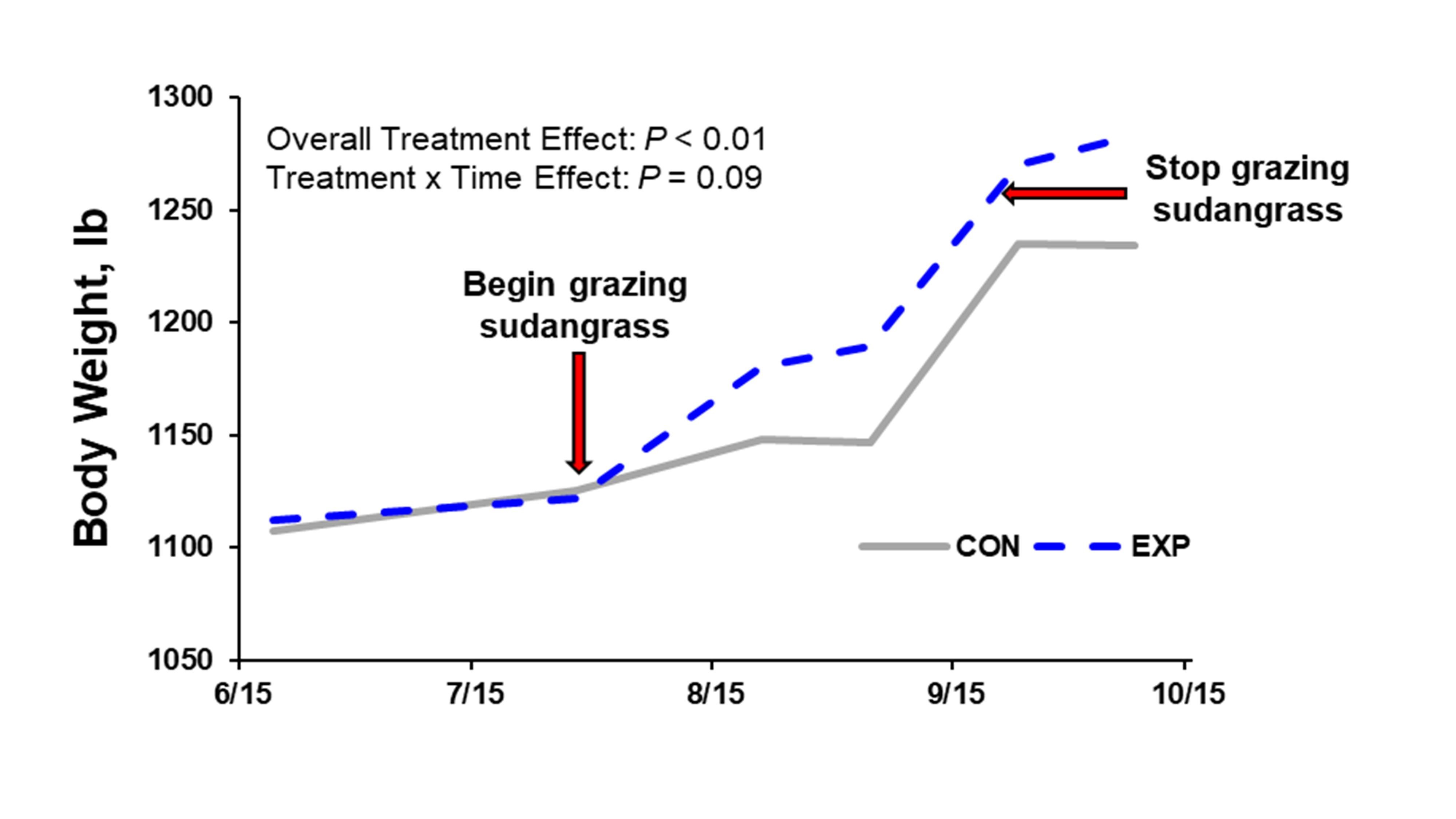During the summer of 2020, a study was conducted at the Central Maryland Research and Education Center dairy farm to investigate the effects of improved pasture management on heifer performance. This study took place between June and October 2020 and utilized 25 pregnant Holstein heifers.
Methods
An existing 25-acre pasture consisting of mostly endophyte-infected tall fescue was divided into two sections to accommodate two treatments: a control treatment (CON) and an experimental, improved pasture management treatment (EXP). The improvements for the EXP treatment were designed to be moderate, lower-intensity changes; these changes included a fertilizer application, implementation of a rotational grazing system (rotation every 2-4 days), and incorporation of a summer annual forage into the rotation. Soil samples obtained in early May were used to guide fertilizer application to the EXP pasture; the EXP pastures were fertilized accordingly on May 20, 2020. Approximately 5 acres of the EXP pasture was terminated in early June and replanted in sudangrass (Hay King II HiGest BMR sudangrass) on June 19, 2020. The EXP pasture was then subdivided into 14 paddocks of approximately 1 acre each to facilitate rotational grazing (Figure 1); heifers in the EXP group were rotated to a new paddock every 2-4 days, depending on forage availability. The pasture for the CON treatment was subdivided into 3 sections of approximately 3-4 acres each (Figure 1); heifers in the CON group were moved every 10-15 days, depending on forage availability.

In addition to pasture, heifers in both groups were supplemented with 1.5 pounds of ground corn and minerals daily. Body weight, hip height, and wither height were measured approximately every 3 weeks. Forage samples were collected approximately every 3 weeks for forage nutritive value analysis; for each treatment group, samples were collected from the paddock immediately prior to grazing.
Results
The average nutrient composition of the forages for the CON and EXP pastures is shown in Table 1. Surprisingly, overall forage nutrient composition was not significantly different across treatment and time. Based on previous research, we expected the nutrient analysis for the sudangrass pasture to be different than the perennial pasture. One potential explanation for this could be that the sudangrass was a little more mature than ideal when first sampled and grazed by the EXP heifers in the current study. Additionally, forage quality in a pasture setting is quite variable, and more frequent forage sampling (> every 3 weeks) would likely have allowed for better capture of the variation in nutrient composition across the different forage types throughout the summer.

Despite the similar nutrient composition of the pastures, heifers on the EXP treatment gained more weight and had significantly greater average daily gains (1.6 vs. 1.0 lb/d) than those on the CON treatment (Figure 2). Heifers on the EXP treatment also had greater gains in whither height than CON heifers, although hip height was not affected by treatment (Figure 3).

Although forage intake was not measured, the greater performance of heifers on the EXP treatment is likely attributed to improved forage utilization, particularly during the time when the sudangrass paddocks were grazed (Figures 1 and 2). It has been well-established that livestock will avoid consuming endophyte-infected tall fescue during periods of hot weather because the endophyte toxins (ergot alkaloids) reduce their ability to cope with heat stress. The relatively low body weight gains for both groups in this study is likely attributed to high temperatures during the study period (average high temperatures for June, July, August, and September were 82, 90, 85, and 76°F, respectively). Performance of the CON heifers and the EXP heifers prior to utilizing the sudangrass pastures was probably also negatively influenced by the reliance on endophyte-infected fescue as the primary forage source during these high temperatures as well as the overall low-input, minimal maintenance history for these pastures. Improvements in a low- or moderate-input pasture system take time; we expect that performance will increase as improvements continue to be made moving forward.

Take Home & Conclusions
While an economic analysis of this strategy is forthcoming, these initial results indicate that making moderate improvements to a pasture system by applying fertilizer (based on soil testing), incorporating a summer annual forage, and implementing a rotational grazing system can improve heifer performance. Producers looking to improve grazing systems on their farm should begin by exploring simple management changes such as fertilizer application and the implementation (or increased intensity) of rotational grazing practices. Incorporation of an annual forage into the grazing system may also help improve performance by offsetting the reduced summer growth (i.e. summer slump) in perennial pastures and mitigating palatability and forage intake issues associated with endophyte-infected fescue pastures during the summer.
Future Plans
A study similar to this will be completed next year; methodology will be similar but will focus on the economic and performance implications of incorporating both winter and summer annual forages into a moderately intensive grazing system. Future studies will continue to explore how improvements in pasture management affect heifer performance and the economic viability of the heifer program.